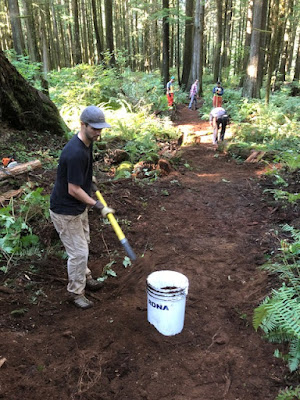Sumas Mountain is widely-regarded within the mountain-biking
community as one of the best. This setting is unique in that the local climate
allows for year-round riding and running. When magnet destinations like
Whistler and Squamish are under metres of snow, die-hard riders can still find
a place to ride.
Not all recreation is equal. If the purpose of
recreation is to provide opportunities for as many residents as possible to
engage in an active lifestyle that will result in a healthier population, where
is it that the City will get the most “bang for its buck”? Recreational assets
can be costly; costly to develop, to maintain, and to operate. One of the
costliest components of any major asset is the land. The City of Abbotsford is
land-poor. That is to say, the city does not possess a large portfolio of land
holdings that are available for development. This and the fact that 75% of our
municipality lies in the Agricultural Land Reserve means that the challenge of
even finding available land will be difficult at best.
If one begins to analyze the cost per user for
major recreational facilities, one begins to realize where the “biggest bang
for buck” does not lie. Prime examples are ice sheets and ball fields. The
sports that use these facilities are age-specific, seasonal, and the numbers
involved pale in comparison to some other recreational “user groups”. This is a
prime reason why the city chooses to rent ice time at Centre Ice, rather than
build another arena. Even pools, which are costly to build and maintain, have a
much larger and non-age-specific user group. Additionally, it is not a seasonal
facility unless it happens to be an outdoor pool.
I haven’t done the math myself but have borrowed it
from someone who has experience working in recreation. His conservative
estimates have ice costing $35,000/user for capital alone. Baseball costs about
$4,500/user. His research shows that the recreation with the lowest cost per
user is disc golf, followed by trails. Based on this very informal analysis, it
would appear that a strong case can be made for the funding of trail-related
recreation.
Let’s be clear, I’m not about to advocate for
diversion of funds from the above-mentioned recreational pursuits. Abbotsford
needs more playing fields (baseball, field hockey, soccer, rugby, etc.) and
pools, but I am saying that there is a case to be made for funding
mountain-based recreation as well. As one mountain-biker told me, “the mountain
is my gym”. He chooses not to use our recreational centre for his
fitness-related activities; he chooses the mountain. It’s a personal choice
that allows him to include his children in year-round outdoor activities, as
well as developing in them an appreciation for this beautiful environment we
call Sumas Mtn.
Then there are the runners. Formed in 2016, the
Abbotsford Trail Running Club has as its mission, “To promote fitness and community through trail running and to advocate
for our local nature trails.” Together, these two recreational communities
were instrumental in halting the commencement of gravel mining on one of the
Fraser Valley’s most pristine mountain environments. I’ve written about this
elsewhere (see Article). This user group advocates for mountain trails and the
preservation of this beautiful resource in much the same way as the mountain
bikers do. Together, they represent a significant group of residents whose
dream is to enjoy our mountains, with the support of local government.
At this point, the Recreation budget has no line
item for trail riders and runners. Several months ago, Metro Vancouver
transferred a large parcel of land on Sumas Mtn to the City of Abbotsford,
which will be under the management of the Fraser Valley Regional District. City
staff are presently engaged in negotiations with their staff and with the Sumas
First Nations to work out a mutually-beneficial plan for its maintenance and
development. Following that, we will be in a better position to consider the
needs of the mountain-biker and trail-running communities, to consider options
for resourcing this recreational pursuit.
It is my understanding that at present, Sumas Mountain
sees thousands of riders on an annual basis riding its trails. Furthermore, all
construction and maintenance of trails is done by an army of volunteer mountain
bikers. The Fraser Valley Mountain Bikers Association has been formed to
organize and direct the activities and use of trails in the Fraser Valley. In
short, this non-profit association acts as the voice of the mountain-biking
community. The trails referred to are used by runners and hikers as well, although
those numbers are not clear to this writer.
So, while I believe that mountain recreation could
provide more “bang for our buck”, and that these user groups need to be
included at our Parks & Recreation table, I am not suggesting that other
recreational pursuits are less important, nor that their resources are in any
way in jeopardy.
I’ve been to the mountain; I’ve seen the results of
their volunteer labour, and I’ve heard their appeal for modest assistance. I
don’t think their ask is unreasonable, and I’m excited about the potential of
this natural capital asset we have in our backyard called Sumas Mountain.







No comments:
Post a Comment